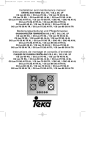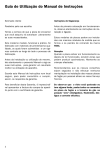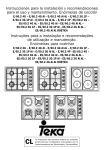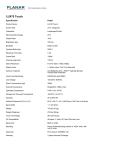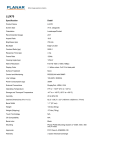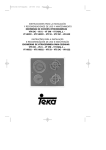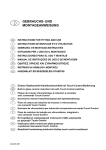Download Teka CG.1 User's Manual
Transcript
Installation and maintenance manual COCINAS CRISTAL-GAS CG.1 4G / CG.1 3G. 1P CG Lux-60 4G. / CG Lux-70 4G. / CG Lux-70 4G AI AL CG Lux-70 5G. / CG Lux-60 4G. Al AL / CG Lux-70 5G. Al AL CG Lux-70 5G AI TR AL / CG Lux-70 5G TR / CGC 4G / CGC 4G AI AL CG Lux-75 2G AI TR AL / CG Lux-86 3G AI TR AL CG Lux-86 2G 1P AI TR AL User’s Guide to this Instruction Manual Dear Customer, Safety Instructions Thank you for choosing a TEKA hob. Before using your hob for the first time, please read the installation and connection instructions. We are sure that our product will fully satisfy your requirements. This modern, functional and practical appliance has been built using top quality materials which are subjected to strict quality controls throughout the manufacturing process. Before installing or using our product, we recommend you to carefully read this manual and to follow its instructions step by step in order to obtain the best possible results. Keep this instruction manual in a safe place so that you can consult it whenever necessar y and comply with the warranty requirements. To benefit from our Warranty you must present proof of purchase together with the warranty cer tificate. 2 These hob models can be installed in the same kitchen units as TEKA ovens and control panels. N.B. To avoid the risk of burns, keep children away from the hob during or after its operation. We recommend you to follow our instructions and that the installation of our hobs be carried out by our Technical Ser vice personnel only. Contents Introduction Description of the Appliance Page 4 4 Installation Positioning of the hobs Positioning of the oven Anchoring of the hob Connecting the hob to the oven or the control panel Gas Connection Electrical Connection Gas transformation 9 9 10 10 Technical Information Dimensions and powers Technical Data Rating Plates 16 16 18 20 Use and Maintenance Special requirements before first use Component Par ts of Gas Burners Lighting of Burners Switching on Electric Hotplates Components of a Safety System Using your Hob Hints for the correct Usage of Burners Hints for the correct Usage of Electric Hotplates Reminder Cleaning and Conservation Electric Hotplates (Mod. CG. 1 3G 1P) Maintenance 24 24 24 24 26 27 29 29 29 30 31 32 32 If Something Doesn´t Work 33 11 12 13 14 3 Introduction Description of the Appliance CG. 1 4G (see drawing 1) CG.1 3G. 1P. (see drawing 2) 1 Auxiliary burner of 860 Kcal/h - 1 kW. 2 Semi fast burner of 1,500 Kcal/h 1.75 kW. 3 Fast burner of 2,550 Kcal/h - 3 kW 4 Semi fast burner of 1,500 Kcal/h 1.75 kW. 1 Auxiliary burner of 860 Kcal/h - 1 kW. 2 High -powe r hotp late of 1,5 00 W, Ø 145 mm. 3 Semi fast burner of 1,500 Kcal/h 1.75 kW. 4 Fast burner of 2,550 Kcal/h - 3 kW. • All burners incorporate a pan suppor t. • Maximum calorific power: 6,400 Kcal/h 7.5 kW. • All burners incorporate a pan suppor t. • Maximum calorific power: 4,900 Kcal/h 5.75 kW. • Maximum electric power: 1,500 Watts. 2 1 2 1 4 3 3 4 Drawing 1 4 Drawing 2 CG-Lux-60 4G. and CG Lux-60 4G AI AL (see drawing 3) 1 Fast burner of 2,580 Kcal/h - 3 kW. 2 Semi fast burner of 1,500 Kcal/h 1.75 kW. 3 Semi fast burner of 1,500 Kcal/h 1.75 kW. 4 Auxiliar y burner of 860 Kcal/h - 1 kW. 5 Burner controls. CGC 4G and CGC 4G AI AL (see drawing 4) 1 Fast burner of 2,580 Kcal/h - 3 kW. 2 Semi fast burner of 1,500 Kcal/h 1.75 kW. 3 Semi fast burner of 1,500 Kcal/h 1.75 kW. 4 Auxiliary burner of 860 Kcal/h - 1 kW. • All burners incorporate a pan suppor t. • Maximum calorific power: 6,450 Kcal/h 7.5 kW. • All burners incorporate a pan suppor t. • Maximum calorific power: 6,450 Kcal/h 7.5 kW. 1 3 1 2 3 4 5 2 4 Drawing 3 Drawing 4 5 CG-Lux-70 5G., and CG Lux -70 5G AI AL (See drawing 5) CG-Lux-70 5G TR and CG Lux -70 5G AI TR AL (See drawing 6) 1 Fast burner of 2,580 Kcal/h - 3 kW. 2 Fast burner of 2,580 Kcal/h - 3 kW. 3 Semi fast burner of 1,500 Kcal/h 1.75 kW. 4 Semi fast burner of 1,500 Kcal/h 1.75 kW. 5 Auxiliary burner of 860 Kcal/h - 1 kW. 6 Burner controls. 1 Fast burner of 2,580 Kcal/h - 3 kW. 2 Triple ring burner of 3,000 Kcal/h 3.5 kW. 3 Semi fast burner of 1,500 Kcal/h 1.75 kW. 4 Semi fast burner of 1, 500 Kcal/h 1.75 kW. 5 Auxiliary burner of 860 Kcal/h - 1 kW. 6 Burner controls. • All burners incorporate a pan support. • Maximum calorific power: 9,450 Kcal/h 11 kW. • All burners incorporate a pan suppor t. • Maximum calorific power: 9,020 Kcal/h 10.5 kW. 1 2 4 6 3 5 Drawing 5 6 1 2 4 6 - - 3 5 Drawing 6 CG-Lux-70 4G and CG Lux -70 4G AI AL (See drawing 7) 1 Fast burner of 2,580 Kcal/h - 3 kW. 2 Semi fast burner of 1,500 Kcal/h 1.75 kW. 3 Semi fast burner of 1,500 Kcal/h 1.75 kW. 4 Auxiliar y burner of 860 Kcal/h - 1 kW. 5 Burner controls. CG-Lux-75 2G AI TR AL (See drawing 8) 1 Triple ring burner of 3,010 Kcal/h 3.5 kW. 2 Triple ring burner of 3,010 Kcal/h 3.5 kW. 3 Burner controls. • All burners incorporate a pan suppor t. • Maximum calorific power: 6,020 Kcal/h 7 kW. • All burners incorporate a pan support. • Maximum calorific power: 6,450 Kcal/h 7.5 kW. 1 3 1 2 5 4 Drawing 7 2 3 Drawing 8 7 CG-Lux-86 3G AI TR AL (See drawing 9) CG-Lux-86 2G 1P AI TR AL (See drawing 10) 1 Triple ring burner of 3,010 Kcal/h 3.5 kW. 2 Triple ring burner of 3,010 Kcal/h 3.5 kW. 3 Semi fast burner of 1,500 Kcal/h 1.75 kW. 4 Burner controls. 1 • All burners incorporate a pan suppor t. • Maximum calorific power: 7,520 Kcal/h 8.75 kW. 1 3 2 • All burners incorporate a pan suppor t. • Maximum calorific power: 6,020 Kcal/h 7 kW. • Maximum electric power: 1,500 Watts. 1 4 3 2 4 Drawing 9 8 Triple ring burner of 3,010 Kcal/h 3.5 kW. 2 Triple ring burner of 3,010 Kcal/h 3.5 kW. 3 High-power hotplate of 1,500 W, Ø 145 mm. 4 Burner controls. Drawing 10 Installation Important INSTALLATION AND ADJUSTMENT MUST BE CARRIED OUT BY AUTHORISED TECHNICAL PERSONNEL ACCORDING TO THE APPLICABLE INSTALLATION REGULATIONS. A Positioning of the hobs Depending on the model to be installed an aperture will be made in the worktop, of the dimensions specified in the drawing 11. A template is included in the packaging of models CG.1 4G. and CG.1 3G. 1P. for the correct sizing of the aperture for these two hob models. B If the hob is installed above kitchen storage units (cupboards, drawers, etc.), an intermediate panel must be fitted. C For hobs with controls, its location must include a ventilation slot at the front, of 110 cm 2. In this case the minimum distance between the lower part of the hob and the upper par t of the furniture below the hob will be 20 mm. If there is no front ventilation slot, the minimum distance between the hob and the upper par t of the furn i t u re must be 130 mm.The hob must be installed at least at 10 cm from its sides to any wall in the room. D E The minimum ver tical distance of the lower part of the piece of furniture placed above the hob will be 600 mm. The piece of furniture where the hob with oven is to be placed will be properly fixed. A B C D E Mod.: Mod.: Mod.: Mod.: Mod.: Drawing 11 CG Lux-60 y CGC 4G CG.1 3G. 1P. y CG.1 4G. CG Lux-70 CG Lux-75 CG Lux-86 * In the case of the granite hob the measurement can be 580 mm. 9 Positioning of the oven In the cases of the models CG.1 4G and CG.1 3G 1P, the clamps must be fitted as shown in the picture 13, depending on the thickness of the furniture. See the applicable manual. Anchoring of the hob Once the hob position has been dimensioned, the seal (J) must be affixed to the lower part of the cooker. This is fastened by means of four clamps (G), each of which has two tabs (P) which are inserted in the apertures (O) in the hob until they click into place. To secure the clamp, open the tab (S) outwards a little as indicated in the figure. Once the seal and the clamps have been positioned the appliance may be installed in its position. For worktops 30 mm thick or less, use the M5 screws supplied as complementary fixation by introducing them into the circular hole of the clamp. A fillet shall form in this hole as the screw is introduced in it. This operation should be done before fastening the clamps to the hob. 20/30 mm. Self-tapping screw for worktops of 20 and 30 mm. wide Use a screwdriver to tighten the screws (T) on the four clamps and the hob will be perfectly secured in place. (See drawing 12). 40 mm. N.B. It is imperative to install the seal under the brim of the worktop. Failure to install this may cause the worktop to be exposed to high temperatures. Drawing 13 To install hob model CGC 4G AI AL, inser t the quick-fix nuts in the screw housings (see drawing 14), connect the clip which corres ponds with the height measurement of the hob unit (20, 30 and 40 mm) and tighten the screws until they are well secure. J S A B O O 20 mm. 30 mm. 40 mm. G P C D E Drawing 14 T Drawing 12 10 A Seal B Work top D Fastening clip C Screw E Quick-fix nut Hob models CG-Lux-75 2G and CG-Lux-86 3G are installed in the same way as the CGC 4G AI AL, except for the staples which are geometrically dif ferent. The installation of these hobs must be carried out in the way shown in the drawing 15, depending on the thickness of the work top. B A 20 mm. 30 mm. 40 mm. Drawing 15 A Seal C B Work top D Fastening clip D If the unit below the hob is to be used to store products it must be situated at a distance of at least 10 cm below the hob. Furthermore, it must be taken into account that the temperature in the interior of the furniture may rise to 60oC. CONNECTING THE HOB TO THE OVEN (Mod. CG.1 4G, CG.1 3G 1P and CGC 4G) OR THE CONTROL PANEL To connect the hob to the oven, four telescopic universal joints are provided. (See drawing 17). E C Screw A E Quick-fix nut CGC 4G Once the hob position has been dimensioned, the seal must be affixed (J) to the hob. Fix the clamps (K) into the holes on the lower part of the case, as shown in drawing, by tightening the four screws supplied (ø4.2 mm). The clamps (K) and seal (J) are supplied in the packaging along with the hob. (See drawing 16). J 20 K J 30 K J 40 K Drawing 16 A B Drawing 17 To make this connection, proceed as follows: 1 Disconnect from the mains supply (mod. CG.1 3G 1P and CGC 4G AI AL). 2 Detach the telescopic universal joints by pressing the retention tab (marked PUSH) using a thin screwdriver and extract the extender a few centimetres. 3 Remove the four lockpins from the ends (B). 4 Partially insert the oven in its position, taking care not to snag the telescopic universal joints which are hanging from the underside of the hob, and leave sufficient space to be able to connect the other ends of the joints to the rods at the rear part of the control panel, before finally connecting the lockpins. 5 For the electrical connection between the two appliances, connect the hob connector to the oven connector (mod. CG.1 3G 1P and CGC 4G AI AL). 11 Rear view of the Control Panel: 1 Fix the hob knob covers on the oven according to the oven instructions manual. Fix the knob covers included with the hob and remove those for the oven. This hob comes complete with knob covers for all TEKA ovens except for models RT-600 and RT-800. For these two models, order the knob covers in your nearest TEKA establishment or official technical service. 3 2 Gas Connection Drawing 18 1 Flexible Power Cable. 2 Connector. 3 Power Unit Protective Casing. 6 Position the oven in its definitive location, ensuring that the telescopic universal joints are well connected to the rods and that the telescopic tubes are introduced well aligned with each other in order to favour their movement. 7 Position the control panel on the oven’s fascia. 8 To operate, the controls must be pressed in and then turned in order to release the safety device. If the telescopic universal joints are too short, extensions can be used. These are inserted at pressure and fastened with the corresponding cover. To make the oven’s electrical connection, consult the oven’s instruction manual. Hob model CGC 4G AI AL This hob should be fitted onto the oven by following the same method, except for item 7, where the procedure shall be as follows: 12 The hob’s gas connection to the mains supply must be made in accordance with the applicable installation regulations and by qualified technical personnel (an authorized installer). The gas connection for these hobs must be by means of rigid piping, given that this is an immobilized appliance, in the case of hobs destined for the EC. The hob is prepared with a 1/ 2 " diameter screw connection according to ISO 228-1, or 1 /2 " diameter conical screw connection to ISO 7-1 according to the regulations of the receiving country. For the markets with 1 /2 " ISO 228-1 connection a copper tube of diameter 10/12 mm is suplied as an accessory. This can be welded to the gas intake pipe. The room must be provided with adequate ventilation, in accordance with the applicable regulations. The gas connection between the hob and the mains gas pipe must be in accordance with the basic regulations for gas installations in homes. TEKA will not accept responsability for faults or damage caused by incorrect or defective instalation. Once the gas connetion has been made the air tightness of the installation mus be checked. If the check is made using air, the testing pre s s u re must be no greater than 200 g/cm 2 . To avoid causing damage to the hob during installation when tightenig the gas pipe connection nut, a maximum grip torque of 350 kg.f.cm must be used. Elbow Union Gasket Straight Hose Holder Drawing 19 After installing the hob, check that the burners’ minimum settings are well regulated. To do this, light the burners and check that they do not go out when brusquely turned from maximum to minimum. Do not connect the hob burners with town gas whose composition contains carbon monoxide, except in models which incorporate a safety device. Each time the gas connection nut is removed the washer must be replaced. The gas connection must be so sited that it is not adversely heated when the appliance is in operation. When the gas hob has been installed, it is essential to check that neither the gas hose nor the electric cable is in contact with hot parts of the appliance or hot gas exhaust, other wise heat damage to the hose and cable could occur. When installation is completed, check that all the gaskets are leaktight and any other possible leak using a soap based solution, never a flame. Electrical Connection (Only for cookers with automatic ignition or with electric hotplates). First of all it must be checked that the mains voltage is the same as that indicated on the appliance’s rating plate. The connection must be made through an omnipolar cut-off switch with a distance of at least 3 mm between the contacts, assuring disconnection in cases of emergency or for the cleaning of the hob. It must also be provided with the correct earth connection in accordance with the applicable regulations. If it comes necessar y to change the flexible power cable in model CG.1 3G. 1P, the replacement must be carried out by TEKA’s official Technical Ser vice as special tools are required. With the other hob models it is also recommended that the replacement be carried out by TEKA’s Techncial Service, though these cables can be ordered from the Technical Service giving the reference CG Lux-60, CG Lux70, CG Lux-75, CG Lux-86 3G and CG Lux-86 2G 1P mains power cable, depending on the model in question. 13 Gas transformation Important! The transformation of the appliance to use a d i ff e rent gas to that for which it has been sold must only be carried out by a qualified technician. Information for the Technical Service: in the event of conversion of the type of gas or pressure in the appliance, the new regulation label must be placed over the existing one, in order to identify the new characteristics after the changeover. To make the transformation replace the gas nozzles and regulate the minimum settings of the taps. The gas nozzles necessar y for each type of gas are indicated in table 1. To replace the gas nozzles it is necessary to follow the following instructions: • Remove the pan suppor ts and the top par t of the burners in order to access the nozzle. • Use a no 7 tubular spanner to remove th e no zz les a nd re pl ac e th em wi th th e corresponding alternative nozzles. Take care to tighten the nozzles well so as to avoid the risk of gas leaks. • Reposition the pan support and burner covers. Once the gas nozzles have been replaced, the following instructions must be followed to graduate the minimum settings. Hob CG.1 4G, CG.1 3G 1P, CGC 4G y CGC 4G AI AL • Remove the oven or the control panel from their place to access the gas taps. • Light the burners at their minimum setting. • Use a small screw driver to remove the screw on the right or centre of the plug of the gas key (turn left for a big flame and right for a small flame). • Once the setting has been graduated check that the flame remains at its minimum setting when the control is brusquely t u rned between the maximum and the minimum setting. Table 1 CG LUX-60, CG LUX-70, CGC 4G, CG.1 4G, CG.1 3G. 1P. CG Lux-75 and CG Lux-86 Burner Family First Triple ring Triple ring 5R (SHA) Fast Semi fast Auxiliary Group a 290 340 260 185 145 Group c 290 340 260 185 145 Gas nozzle diameter (Ø) expressed in 1/100 mm 14 Second Group e 290 340 260 185 145 Group H 135 116 97 72 Group E+ 135 116 97 72 Third Group 3+ 95 85 65 50 • In order to access the screw which graduates the gas flow through the taps in hob CGC 4G AI AL, remove the screws that fix the cover protecting the taps to the case and lift the cover. Others hobs • Remove the tap controls by pulling them upwards strongly. • Light the burners at their minimum setting. • Use a small screw driver to remove the screw on the right or centre of the plug of the gas key (turn left for a big flame and right for a small flame). • Once the setting has been graduated check the the flame remains at its minimum setting when the control is brusquely t u rned between the maximum and the minimum setting. Models CG LUX-75 and CG LUX-86 regulated for town gas can not be transformed to operate neither natural nor butane gas. The only intervention necessar y for the transformation is the replacement of the gas nozzles and their setting. TEKA INDUSTRIAL, S.A. will not accept responsibility for incorrect hob operation if the gas transformation and regulation of minimum burner settings are not carried out by TEKA’s official Technical Ser vice. 15 Technical information Dimensions and powers Models Dimensions in mm Length Width Depth Glass thickness Worktop hob dimensions mm. Length Width 3.5 kW Triple ring gas burner 3 kW fast burner 1.75 kW semi fast burner 1 kW auxiliary burner 1,000 W electric hotplate Ø 145 mm. 1,500 W electric hotplate Ø 145 mm. 1,500 W electric hotplate Ø 180 mm. CG.1 4G CG.1 3G. 1P. CG Lux-60 4G AI AL CG Lux-60 4G. CGC 4G CGC 4G AI AL CG Lux-70 4G. 590 510 120 5 590 510 120 5 610 510 75 8 610 510 75 8 600 510 100 8 600 510 100 8 710 510 70 8 570 492 570 492 580 490 580 490 580 490 580 490 690 490 1 1 1 1 1 1 1 2 1 2 2 2 2 2 1 1 1 1 1 1 1 1 Electric Maximum nominal power W Supply voltage V Frequency Hz Gas Maximum power kW 16 7,5 1.500 0,6 0,6 230 50/60 220/240 50/60 220/240 50/60 5,75 7,5 7,5 7,5 7,5 7,5 Models Dimensions in mm Length Width Depth Glass thickness Worktop hob dimensions mm. Length Width 3.5 kW Triple ring gas burner 3 kW fast burner 1.75 kW semi fast burner 1 kW auxiliary burner 1,000 W electric hotplate Ø 145 mm. 1,500 W electric hotplate Ø 145 mm. 1,500 W electric hotplate Ø 180 mm. CG Lux-70 CG Lux-70 CG Lux-70 CG Lux-70 CG Lux-70 CG Lux-75 CG Lux-86 CG Lux-86 4G AI AL 5G. 5G AI AL 5G AI TR AL 5G. TR 2G AI TR AL 3G AI TR AL 2G 1P AI TR AL 710 510 70 8 710 510 70 8 710 510 70 8 710 510 70 8 710 510 70 8 750 450 70 8 860 450 70 8 860 450 70 8 690 490 690 490 690 490 690 490 690 490 670 350 815 405 815 405 1 1 2 2 2 1 2 2 1 1 2 2 2 2 2 1 1 1 1 1 1 Electric Maximum nominal power W 0,6 Supply voltage V 220/240 Frequency Hz 50/60 Gas Maximum power kW 1 7,5 0,6 0,6 0,6 220/240 220/240 50/60 50/60 10,5 10,5 11 0,6 220/240 220/240 50/60 50/60 11 7 8,75 1.500 230 50/60 7 17 Technical Data COMMON CHARACTERISTICS TO THE ELECTRIC HOTPLATES AND AUTOMATIC LIGHTING MODEL The supply voltage and frequency must be those indicated in the rating plate. The fire p rotection is of “X” type. The hob must be installed at over 15 cm away from the side walls. (See drawing 20). In the event of a hotplate being cracked the hob must be switched off at the mains. c) “This appliance must not be connected to a device for the evacuation of combustion products. Its installation and connection will be carried out according the installation rules in force. Special attention will be paid to the applicable specifications concerning ventilation”. Attention: The use of a gas cooking appliance, produces heat and humidity in the room where it is installed. Good ventilation of the kitchen must be ensured by keeping the natural ventilation holes open or by opening a window or installing an efficient mechanical ventilation device (mechanical ventilation hood). COMMON CHARACTERISTICS TO EVERY MODEL WITH GAS BURNERS Warnings: a) “Before installing, make sure that the local distribution conditions (gas type and pressure) are compatible with the setting of the appliance”. b) “ The setting conditions, of this appliance are printed on the label (or the rating plate)”. Table 2 Country Spain Portugal France United Kingdom Greece 18 Category III1ace2H3+ II2H3+ II2E+3+ II2H3+ I3+ Drawing 20 COMMON CHARACTERISTICS TO EVERY MODEL N.B.: All the hob models referred to in this manual have hot zones during or after their use and can cause burns. Care must be taken when handling these hobs before installation as there may be rough zones or corners which may be dangerous. Table 3 Burner Nominal calorific consumption Nominal consumptions* CCR CG Lux-60, CG Lux-70 CGC 4G, CG.1 4G and CG.1 3G. 1P CCR CG Lux-75 and CG Lux-86 Efficiency Triple ring Large Standard Small kW 3,5 3 1,75 1 G-130 (Nm3/h) 0,49 0,42 0,24 0,14 G-150 (Nm3/h) 0,63 0,54 0,31 0,18 G-110 (Nm3/h) G-20 (Nm3/h) G-25 (Nm3/h) G-30 (Kg/h) G-31 (Kg/h) 0,79 0,33 0,38 0,25 0,24 0,68 0,29 0,33 0,22 0,21 0,40 0,17 0,19 0,13 0,13 0,23 0,10 0,11 0,07 0,07 kW kW % 1,55 1,55 >52 0,77 – >52 0,47 0,47 >52 0,33 – – * On standard calorific power 19 TEKA INDUSTRIAL, S.A. SANTANDER - ESPAÑA CG.1 4G Mod. ∑ Qn (P.C.S.) 3 Clase CG LUX 60 4G Mod. ∑ Qn Nº 7.50 TEKA INDUSTRIAL, S.A. SANTANDER - ESPAÑA (P.C.S.) 3 Clase Nº 7.50 G-110 Vr 1.70 Nm3/h G-20 Vr 0.71 Nm /h G-110 Vr 1.70 Nm3/h G-20 Vr 0.71 Nm3/h G-130 Vr 1.05 Nm3/h G-25 Vr 0.83 Nm3 /h G-130 Vr 1.05 Nm3/h G-25 Vr 0.83 Nm3/h G-150 Vr 1.35 Nm3/h G-30 Mr 0.55 Kg/h G-150 Vr 1.35 Nm3/h G-30 Mr 0.55 Kg/h G-31 Mr 0.54 Kg/h G-31 Mr 0.54 Kg/h ES 3 FR Cat. Kat III1ace2H3+ ES II2E+3+ p (mbar) 8-18-28/37 20/25 28/37 Cat. Kat GB GR II2H3+ I3+ Cat. Kat H∆EKTPIKO II2E+3+ p (mbar) 8-18-28/37 20/25 28/37 PT II2H3+ p (mbar) 20-28/37 28/37 20-30/37 ELECT. FR Cat. Kat III1ace2H3+ GB GR II2H3+ I3+ PT II2H3+ p (mbar) 20-28/37 28/37 20-30/37 ELECT. H∆EKTPIKO 0099 0099 TYP. B1221300A TYP. A1322100A TEKA INDUSTRIAL, S.A. SANTANDER - ESPAÑA CG.1.3G.1P Mod. ∑ Qn (P.C.S.) CG LUX 70 4G Mod. ∑ Qn Nº 5.75 G-110 Vr 3 Clase TEKA INDUSTRIAL, S.A. SANTANDER - ESPAÑA (P.C.S.) 3 Clase Nº 7.50 1.30 Nm3 /h G-20 Vr 0.55 Nm3/h G-110 Vr 1.70 Nm3/h G-20 Vr 0.71 Nm3/h G-130 Vr 0.80 Nm3 /h G-25 Vr 0.64 Nm /h G-130 Vr 1.05 Nm3/h G-25 Vr 0.83 Nm3/h G-150 Vr 1.03 Nm3/h G-30 Mr 0.42 Kg/h G-150 Vr 1.35 Nm3/h G-30 Mr 0.55 Kg/h G-31 Mr 0.41 Kg/h G-31 Mr 0.54 Kg/h ES 3 FR Cat. Kat III1ace2H3+ ES II2E+3+ p (mbar) 8-18-28/37 20/25 28/37 Cat. Kat GB GR II2H3+ I3+ p (mbar) 20-28/37 28/37 20-30/37 ELECT. H∆EKTPIKO 220…230 V ~ 50/60 Hz. 1.500 W TYP. B1D21300A 20 II2E+3+ p (mbar) 8-18-28/37 20/25 28/37 PT II2H3+ FR Cat. Kat III1ace2H3+ Cat. Kat GB GR II2H3+ I3+ PT II2H3+ p (mbar) 20-28/37 28/37 20-30/37 ELECT. H∆EKTPIKO 0099 0099 TYP. A1322100A TEKA INDUSTRIAL, S.A. SANTANDER - ESPAÑA Mod. ∑ Qn (P.C.S.) CG LUX 70 5G 3 Clase Mod. ∑ Qn Nº 10.5 TEKA INDUSTRIAL, S.A. SANTANDER - ESPAÑA (P.C.S.) CG LUX 70 5G AI AL CG LUX 70 5G AI 3 Clase Nº 10.5 G-110 Vr 2.38 Nm3 /h G-20 Vr 1.00 Nm /h G-110 Vr 2.38 Nm 3/h G-20 Vr 1.00 Nm 3/h G-130 Vr 1.47 Nm3 /h G-25 Vr 1.16 Nm3/h G-130 Vr 1.47 Nm 3/h G-25 Vr 1.16 Nm 3/h G-150 Vr 1.89 Nm3/h G-30 Mr 0.77 Kg/h G-150 Vr 1.89 Nm3 /h G-30 Mr 0.77 Kg/h G-31 Mr 0.75 Kg/h G-31 Mr 0.75 Kg/h ES 3 FR Cat. Kat III1ace2H3+ ES II2E+3+ p (mbar) 8-18-28/37 20/25 28/37 Cat. Kat GB GR II2H3+ I3+ p (mbar) 20-28/37 28/37 20-30/37 ELECT. H∆EKTPIKO Cat. Kat TYP. A1323210A GB GR II2H3+ I3+ PT II2H3+ p (mbar) 20-28/37 28/37 20-30/37 ELECT. 0099 II2E+3+ p (mbar) 8-18-28/37 20/25 28/37 PT II2H3+ FR Cat. Kat III1ace2H3+ H∆EKTPIKO 220…240 V ~ 50/60 Hz. 0,6 W 0099 TYP. A1323210I TEKA INDUSTRIAL, S.A. SANTANDER - ESPAÑA Mod. ∑ Qn (P.C.S.) CG LUX 60 4G AI AL CG LUX 60 4G AI 3 Clase Nº 7.50 G-110 Vr 1.70 Nm3/h G-20 Vr 0.71 Nm3/h G-130 Vr 1.05 Nm3/h G-25 Vr 0.83 Nm3/h G-150 Vr 1.35 Nm3 /h G-30 Mr 0.55 Kg/h G-31 Mr 0.54 Kg/h ES FR Cat. Kat III1ace2H3+ II2E+3+ p (mbar) 8-18-28/37 20/25 28/37 Cat. Kat GB GR II2H3+ I3+ PT II2H3+ p (mbar) 20-28/37 28/37 20-30/37 ELECT. H∆EKTPIKO 220…240 V ~ 50/60 Hz. 0,6 W 0099 TYP. A1322100I 21 TEKA INDUSTRIAL, S.A. SANTANDER - ESPAÑA TEKA INDUSTRIAL, S.A. SANTANDER - ESPAÑA Mod. ∑ Qn (P.C.S.) CG LUX 70 4G AI AL CG LUX 70 4G AI 3 Clase ∑ Qn Nº 7.50 CGC 4G Mod. (P.C.S.) 3 Clase Nº 7.50 G-110 Vr 1.70 Nm3/h G-20 Vr 0.71 Nm3/h G-110 Vr 1.70 Nm3 /h G-20 Vr 0.71 Nm 3/h G-130 Vr 1.05 Nm3/h G-25 Vr 0.83 Nm3/h G-130 Vr 1.05 Nm 3/h G-25 Vr 0.83 Nm 3/h G-150 Vr 1.35 Nm3/h G-30 Mr 0.55 Kg/h G-150 Vr 1.35 Nm 3/h G-30 Mr 0.55 Kg/h G-31 Mr 0.54 Kg/h G-31 Mr 0.54 Kg/h ES ES FR Cat. Kat III1ace2H3+ p (mbar) 8-18-28/37 20/25 28/37 Cat. Kat GB GR II2H3+ I3+ Cat. Kat GB GR II2H3+ I3+ H∆EKTPIKO 0,6 W 0099 0099 TYP. B1322100A TYP. A1322100I TEKA INDUSTRIAL, S.A. SANTANDER - ESPAÑA Mod. CG LUX 70 5G TR ∑ Qn (P.C.S.) G-110 Vr PT II2H3+ p (mbar) 20-28/37 28/37 20-30/37 ELECT. H∆EKTPIKO 220…240 V ~ 50/60 Hz. II2E+3+ p (mbar) 8-18-28/37 20/25 28/37 PT II2H3+ p (mbar) 20-28/37 28/37 20-30/37 ELECT. FR Cat. Kat III1ace2H3+ II2E+3+ 3 Clase CGC 4G AI AL Mod. ∑ Qn Nº 11 TEKA INDUSTRIAL, S.A. SANTANDER - ESPAÑA (P.C.S.) 3 Clase Nº 7.50 2.5 Nm3 /h G-20 Vr 1.04 Nm3/h G-110 Vr 1.70 Nm3/h G-20 Vr 0.71 Nm3/h G-130 Vr 1.54 Nm3/h G-25 Vr 1.22 Nm /h G-130 Vr 1.05 Nm3/h G-25 Vr 0.83 Nm3/h G-150 Vr 1.98 Nm3/h G-30 Mr 0.81 Kg/h G-150 Vr 1.35 Nm3/h G-30 Mr 0.55 Kg/h G-31 Mr 0.80 Kg/h G-31 Mr 0.54 Kg/h ES 3 FR Cat. Kat III1ace2H3+ ES II2E+3+ p (mbar) 8-18-28/37 20/25 28/37 Cat. Kat GB GR II2H3+ I3+ p (mbar) 20-28/37 28/37 20-30/37 ELECT. H∆EKTPIKO TYP. A1324210A 22 Cat. Kat GB GR II2H3+ I3+ PT II2H3+ p (mbar) 20-28/37 28/37 20-30/37 ELECT. 0099 II2E+3+ p (mbar) 8-18-28/37 20/25 28/37 PT II2H3+ FR Cat. Kat III1ace2H3+ H∆EKTPIKO 220…240 V ~ 50/60 Hz. TYP. A1324210A 0,6 W 0099 TEKA INDUSTRIAL, S.A. SANTANDER - ESPAÑA Mod. CG LUX 70 5G AITR AL CG LUX 70 AI TR ∑ Qn Mod. CG LUX 75 2G AI TR AL CG LUX 75 2G AI TR ∑ Qn Nº 11 (P.C.S.) 3 Clase TEKA INDUSTRIAL, S.A. SANTANDER - ESPAÑA Nº 7 (P.C.S.) 3 Clase G-110 Vr 2.50 Nm3/h G-20 Vr 1.04 Nm /h G-110 Vr 1.59 Nm3/h G-20 Vr 0.66 Nm3/h G-130 Vr 1.54 Nm3/h G-25 Vr 1.22 Nm 3/h G-130 Vr 0.98 Nm3/h G-25 Vr 0.77 Nm3/h G-150 Vr 1.98 Nm3 /h G-30 Mr 0.81 Kg/h G-150 Vr 1.26 Nm3/h G-30 Mr 0.51 Kg/h G-31 Mr 0.80 Kg/h G-31 Mr 0.50 Kg/h ES 3 FR Cat. Kat III1ace2H3+ ES II2E+3+ p (mbar) 8-18-28/37 20/25 28/37 Cat. Kat GB GR II2H3+ I3+ Cat. Kat H∆EKTPIKO 220…240 V ~ 50/60 Hz. GB GR II2H3+ I3+ H∆EKTPIKO 220…240 V 50/60 Hz. 0099 TYP. A1324210I ~ 0,6 W ∑ Qn (P.C.S.) CG LUX 86 3G AI TR AL CG LUX 86 3G AI TR Clase 3 TEKA INDUSTRIAL, S.A. SANTANDER - ESPAÑA Mod. 3 CG LUX 86 2G 1PAI TR AL Clase ∑ Qn Nº 8.75 G-110 Vr 0099 TYP. A1404000I TEKA INDUSTRIAL, S.A. SANTANDER - ESPAÑA Mod. PT II2H3+ p (mbar) 20-28/37 28/37 20-30/37 ELECT. 0,6 W II2E+3+ p (mbar) 8-18-28/37 20/25 28/37 PT II2H3+ p (mbar) 20-28/37 28/37 20-30/37 ELECT. FR Cat. Kat III1ace2H3+ (P.C.S.) Nº 7 1.98 Nm3/h G-20 Vr 0.83 Nm 3/h G-110 Vr 1.59 Nm 3/h G-20 Vr 0.66 Nm3/h G-130 Vr 1.22 Nm3/h G-25 Vr 0.97 Nm /h G-130 Vr 0.98 Nm 3/h G-25 Vr 0.77 Nm3/h G-150 Vr 1.57 Nm3/h G-30 Mr 0.64 Kg/h G-150 Vr 1.26 Nm3 /h G-30 Mr 0.51 Kg/h G-31 Mr 0.63 Kg/h G-31 Mr 0.50 Kg/h ES 3 FR Cat. Kat. III1ace2H3+ ES II2E+3+ p (mbar) 8-18-28/37 20/25 28/37 Cat. Kat. GB GR II2H3+ I3+ p (mbar) 20-28/37 28/37 20-30/37 ELECT. H∆EKTPIKO 220…240 V 50/60 Hz. TYP. A1042004I ~ 0,6 W Cat. Kat. GB GR II2H3+ I3+ PT II2H3+ p (mbar) 20-28/37 28/37 20-30/37 ELECT. 0099 II2E+3+ p (mbar) 8-18-28/37 20/25 28/37 PT II2H3+ FR Cat. Kat. III1ace2H3+ H∆EKTPIKO 230 V 50/60 Hz. ~ 1.500 W 0099 TYP. A1E04E04LE 23 Use and Maintenance Special requirements before first use Before connecting the hob to the power supply check that the voltage and frequency are those indicated in the rating plate located on the lower par t of the hob. Remove the protecting plastic af fixed to the hob, if any. N.B. Each time you assemble a burner, check that all of its component parts fit together correctly. A badly positioned component may cause the hob glass to overheat. Lighting of burners For hobs models CGC 4G, CG.1 4G. and CG.1 3G. 1P. (See drawing 22). • Check that the controls are in the correct position. Component Parts of Gas Burners • Open the mains connection gas tap or the gas bottle cock. A B C • Put a lit match, lighter or flame, etc. next to the burner if no automatic lighting is available. While keeping the burner control pressed, turn it in anti-clockwise direction as far as it will go until the maximum setting (large flame “C”). The burner operates at that moment at full power. Then, if desired, turn the control to the minimum position (small flame “D”). D A E B C F E Drawing 21 A Pan suppor t supplement B Pan support C Burner cover D Burner head E Gas nozzle F Nozzle unit Drawing 22 A Burner indicator B Setting indicator C Off setting D Minimun gas setting E Maximun gas setting 24 D For hobs CG Lux-60, CG Lux-70, CG Lux-75 and CG Lux-86, which have automatic ignition and a safety feature, the following steps should be followed: (See drawing 23) • Check that the controls are in the correct position. • Open the mains connection gas tap or the gas bottle cock. • Press the burner control. • While keeping the burner control pressed, turn it as far as it will go until the gas ignites. Keep pressed for 5 to 10 seconds, in order to permit the safety thermocouple to be activated. • Turn the control to the desired position. • Check that the control knobs are in the appropriate position. • Open the gas flow key or the gas cylinder key. • Press the control knob and turn it at the same time in anti-clockwise direction as far as it will go to the ignition setting (ignition illustration). Once gas has been lit, keep the control knob at this setting for 5 to 10 seconds to let the safety thermocouple act. • Set the control knob to the desired position. A B C D The ignition unit (ceramic and electrode) must be carefully cleaned at regular intervals in order to prevent ignition problems. Also check that the burner apertures are not obstructed. A B F A B C D E F E Drawing 24 Burner indicator Setting indicator Off setting Minimum gas setting Maximum gas setting On burner setting For safety reasons we recommend that the gas supply tap should be turned off when the cooker is not in use, in accordance with gas supply company instructions. C D Drawing 23 A Burner pilot lamp B Control off position C Maximum gas position If you smell gas, turn off the hob’s gas supply tap and ventilate the room. The gas installation and the hob must be checked by a specialized technician. Warning: D Minimum gas position Follow the instructions below in order to operate a CGC 4G AI AL hob: (See drawing 24) To avoid the risk of burns, keep children away from the hob during or after its operation. 25 Use flat bottomed pans and check that they are placed correctly on the pan suppor t, in order to prevent pans from sliding when their contents star t to boil (do not use pans with concave or convex bases). The red-point hotplate (1,500 W) heats up especially quickly and at its maximum power during approximately the first five minutes. After this time its power drops to 500 W and it conser ves the same temperature. Hob models CG-Lux-75 and CG-Lux-86 are provided with a special pan suppor t which permits the use of concave-bottom pans (woks). The control panel features a square drawing containing circles beside each control knob, indicating to which hotplate the control corresponds. The minimum diameter of the pans to be used is 140 mm. For pans of 120 mm diameter or less, use the small burner with the pan support supplement. On the same panel there is a pilot light which indicates the operation of one or more hotplates. B A Switching on Electric Hotplates The electric hotplates are controlled by a seven step switch. To obtain different powers the corresponding control must be turned to the desired setting. (See drawing 25). The pan should be placed on the electric hotplate before it is switched on. The powers corresponding to each setting of the control knob are shown in the following table: Hotplate Ø 145 – 1500 W. Control at Power 0 Disconnected 1 135 W. 2 165 W. 3 250 W. 4 500 W. 5 750 W. 6 1500 W. These hobs have zones which become hot during and after their use and can cause burns. 26 C A Hotplate operation pilot B Control indicator C Pilot light Drawing 25 When connecting the hotplate for the first time, or if the plate has not been used in a long time, it is necessar y to dr y out any humidity which may have been absorbed by the insulation. To achieve this, switch the hotplate on, without any pan, for five minutes at power position 2. TEKA Industrial, S.A. will accept no responsibility for possible inaccuracies contained in this instruction manual due to transcription or printing errors. It also reser ves the right to make any modifications it considers necessary or useful to its appliances without affecting their essential characteristics. Components of a Safety System On all the hobs which incorporate the safety feature (models with initials AL), the gas cutoff system is comprised formed by the following elements: (See drawing 26). G C F A • Safety tap • Safety thermocouple next to the burner • Thermocouple-tap connection B E D Drawing 26 The thermocouple sends an electrical signal to the tap, detecting the presence or absence of a flame at the burner. During ignition the tap must be kept pressed in for 5 to 10 seconds until the thermocouple heats up and sends the flame confirmation signal to the tap. If the flame goes out, its absence is detected by the thermocouple and the safety tap cuts off the supply of gas. A Safety thermocouple B Thermocouple-tap connection C Connection to the sparking unit D Sparking unit E Ceramic head F Electrode G Safety tap 27 Using your Hob • Do not use the glass surface as a storage area. • Do not put aluminium plates, tinfoil or plastics on the glass surface. • On hobs which have five burners, pans of l a rge diameters must always be placed on the central burner in order to prevent heat from being reflected onto the worktop. On hobs with four burners you should use the pan suppor t supplement with this type of pan. A Drawing 27 • When cooking with a griddle pan, stoneware pots or pans which reflect heat downwards, you must use the pan support supplement, other wise the excessive temperature which is reflected downwards may damage the hob glass or the burners. • The pan suppor t supplement can be used to cook with pans of small diameters, when ver y little heat is needed, to cook very slowly, or to keep food warm. Burner efficiency is lost when the pan support supplement is used. • If you detect any breakage or cracking in the hob glass, switch all the burner controls to the of f position (‘0’), turn of f the gas connection and disconnect the electricity supply. Contact your TEKA Technical Service. 28 B Drawing 28 A Griddle pan, stoneware pots or pans which reflect heat downwards B Pan support supplement Suggestions and Recommendations Hints for the Correct Usage of Burners • Do not use large burners with pans of small diameters as par t of the flame will be deflected around the outside of the pan, thus considerably reducing efficiency. (See drawing 29) A hob, in order to prevent deflected flames from damaging worktops with plastic surfaces. Hints for the Correct Usage of Electric Hotplates For maximum ef ficiency with electric hotplates, follow these guidelines: • Use pans with totally flat bottoms. The greater the area in contact with the plate, the greater the transmission of heat. Pans with thick bottoms are recommended as these are more resistant to denting. Notice in the figure 30 how the contact area is smaller when the pan bottom is dented or warped. B Drawing 29 A Right B Wrong • Lit burners must not be left uncovered, in order to avoid the wastage of gas and to prevent the excessive heating of the pan support. • When the burners are lit they must not be exposed to strong drafts. As well as reducing their calorific power there is a risk that the flame may be blown out, leading to gas leaks which could cause an accident. Care should be taken in this re spect par ticularly when burners are operating at a low setting. • If the burner causes the blackening of pans, or if the points of the flames are yellow, it needs to be cleaned. If this fault persists, get in touch with your Technical Service to adjust the primary air setting or to clean the gas pipe. • Do not use cast iron pans directly on the pan support as they reflect excessive heat towards the hob. • Pans placed on the burners must not be allowed to protrude over the edges of the A A Right B B Wrong B Drawing 30 • Do not use pans whose diameter is smaller than that of the hotplate. This avoids the risk of boiling food spilling onto the hotplate. • Dr y the bottom of all pans before placing them on the electric hotplates. • When you have almost finished cooking it is recommended to switch the hotplate to its minimum setting or to switch it off completely a few moments before removing the pan. This allows use to be made of storedup energy and prevents the hotplate from working without a load. NEVER LEAVE AN ELECTRIC HOTPLATE UNCOVERED 29 Reminder Do not use small pans on large burners, as the flame will be dissipated. Use appropriately sized pans for each burner, thus making the best use of the heat. Do not place pans unevenly on the pan support. Place the pan correctly over the centre of the burner. Do not use pans which reflect excessive heat downwards directly on the pan support. When using a griddle pan, stoneware pots or pans which reflect heat downwards, always use the pan support supplement. Do not place pans directly on the burner. Always place pans on the pan support. Do not use sharp objects on the hob. After use, pan suppor ts should be cleaned when cold. Avoid excessive weights or blows to the hob with heavy objects. Handle pans with care on the cooker. 30 Cleaning and Conservation For the correct conser vation of the hob glass it must be cleaned using the appropriate products and utensils and when the glass is cold. Cleaning is easier if it is done each time the hob is used, thus preventing the build-up of dir t. The cleaning of the hob glass will depend on its degree of dirtiness: • When the hob is only slightly dir ty and the dirt is not adhered, clean with a damp cloth and mild detergent. • Stains or grease should be removed using cleaning products suitable for glass (ceramic cleaners). • When dirt is strongly adhered or burnt-on, it should be removed by scraping with a razor blade. • If plastic objects/utensils or sugar has melted on the sur face of the glass, these should be scraped off immediately, before the glass cools off. • Under no circumstances should aggressive or abrasive cleaning products, such as oven cleaners, deoxidizing stain removers, sponges with hard sur faces or scourers, be used. • Do not slide pans across the glass. This may cause scratching. • Take care to prevent pans from boiling dr y. The heat accumulated in the bottom of the pan could cause damage to the burner or to the hob glass. • The hob glass will withstand light blows by large pans which do not have sharp edges. Care should be taken to avoid impacts by small sharp utensils. Do not strike the edge of the glass with pans as this may cause irreparable damage. • Do not spill cold liquids on the glass or the burners when they are hot. • Do not stand or lean on the glass. It may break and cause injur y. Cleaning and conservation of other elements: • Pan supports should be cleaned with a non-abrasive scourer after they have cooled off. • Burners must be cleaned periodically, particularly the grooves in the burner heads. This is achieved by soaking in warm soapy water and scrubbing with a scourer or a stiff brush. • Do not clean the enamelled burner covers when they are still hot. Damage can be caused by abrasive products, such as vinegar, coffee, milk, salt water and tomato juice, as a result of prolonged contact with the enamelled surfaces. • Stainless steel must be washed with soapy water and a soft cloth. If the surface continues to be yellow after washing we recommend the use of lemon, vinegar, diluted bleach or a cleaning product which contains bleach. The shine of stainless steel is maintained by lightly buffing with a metal polish. • The control panel should be cleaned with soapy water and a soft cloth. • When the burners have been dismantled for cleaning purposes, care should be taken to prevent liquids or other objects from entering the nozzle unit. • Do not use cleaning products which are aggressive to aluminium, such as caustic soda, oil, etc. • Each time you assemble a burner, check that all of its component parts fit together correctly. A badly positioned element may cause the hob glass to overheat. 31 Electric Hotplates (Mod. CG.1 3G. 1P.) Maintenance Before cleaning, disconnect the appliance from the mains supply. No part of this appliance requires period lubrication, though the gas tap cones should be kept clean and well greased. Electric hotplates should be cleaned with soapy water and a non-abrasive scourer. If, after cooking, the stainless steel ring of the hotplate or cooker frame is seem to be slightly yellow, this may be cleaned using lemon, vinegar, diluted bleach or any cleaning product which contains bleach. Each time the gas taps are dismantled, the washer which connects them with the distribution pipe should be replaced. Do not clean the hotplates when they are still hot. The burners are operating correctly when their flame is stable and of a blue-green colour. If the points of the flame are yellow the burners should be well cleaned. If the problem persists, contact your Technical Service. If any liquid is spilt on the hotplates this should be removed instantly with a dr y cloth. Never allow remains of food to carbonize on the hotplate as this will reduce its heat transmission capacity. To guarantee the airtightness of the gas installation and the correct operation of the burners, the hob must be serviced by the specialized Technical Service at least once ever y four years. After using the hotplate it must be greased, leaving its surface shiny and preventing rusting. N.B. To extend the lifetime of the hotplate, excessive humidity or temperature should be avoided where possible. Steam appliances must not be used to clean the heating plate. 32 Any required modification or setting of the appliance must be carried out by authorized technical personnel. Important If Something Doesn’t Work Before calling the Technical Service, make the following checks: Fault Possible Cause Neither the hob nor the pilot light works. The mains cable is not connected. No spark appears when the automatic ignition switch is pressed. Power is not reaching the plug. Solution Connect the mains cable. Check / repair the mains supply. A spark appears but the burner does not ignite. The sparking plug and the corresponding burner zone is dirty or coated with grease. Clean the end of the sparking plug and the burner. Gas is not reaching the hob. Check that the gas bottle regulator is correctly positioned and open. Open the gas connection tap in the case of mains gas. There is no flame in the thermocouple zone. The gas burners blacken the pans. Burner apertures dirty. Gas nozzle or diffuser dirty. Clean burner apertures. Clean gas nozzle or diffuser without using objects which could damage or alter the diameter of the gas outlet orifice. The burners do not ignite. The burner ignites but when the safety switchis released it goes out. Clean the burner apertures. 33 TEKA GROUP COUNTRY CITY COMPANY CC PHONE FAX Austria Belgium Chile China Czech Republic France Greece Hungary Indonesia Malaysia Wien Zellik Santiago de Chile Shanghai Brno Paris Athens Budapest Jakarta Kuala Lumpur 43 32 56 86 42 33 30 36 62 1 - 86680 - 20 2466 - 8740 2 - 273.19.45 21 - 6236 - 2375 05 - 4921 - 0479 1 - 4891 - 3788 10 - 9760283 1 - 354.21.10 21 - 39052 - 74 1 - 86680 - 82 2446 - 7687 2 - 273.10.88 21 - 6236-2379 05 - 4921 - 0479 1 - 4891 - 2973 10 - 9712725 1 - 354.21.15 21 - 39052 - 79 Mexico Poland Portugal Singapore Thailand The Netherlands Turkey U.K. U.S.A Venezuela Mexico D.F. Warszawa Ilhavo Singapore Bangkok Zoetermeer Istanbul Abingdon Tampa Caracas KÜPPERSBUSCH GES.M.B.H. B.V.B.A. KÜPPERSBUSCH S.P.R.L. TEKA CHILE S.A. TEKA CHINA LTD. TEKA-SWIAG S.R.O. TEKA FRANCE S.A.R.L . TEKA HELLAS S.A. TEKA HUNGARY KFT. P.T. TEKA BUANA TEKA KÜCHENTECHNIK (MALAYSIA) SDN.BHD. TEKA MEXICANA S.A. DE C.V. TEKA POLSKA SP. Z O O. TEKA PORTUGUESA LTDA. TEKA SINGAPORE PTE. LTD. TEKA (THAILAND) CO. LTD. TEKA BV TEKA TEKNIK MUTFAK A.S. TEKA PRODUCTS (UK) LTD. TEKA USA, INC TEKA ANDINA, S.A. 60 52 48 351 65 66 31 90 44 1 58 3 - 762.01.600 555 - 762.04.90 22 - 652.18.94 234.32.95.00 6 - 73 - 42415 2 - 5164954 79 - 345.15.89 212 - 274.61.04 1235 - 86.19.16 800 - 419 - 9344 2 - 291.28.21 3 - 762.01.626 555 - 762.05.17 22 - 850.12.48 234.32.54.57 6 - 73 - 46881 2 - 9021484 79 - 345.15384 212 - 274.56.86 1235 - 83.21.37 813 - 228 - 8604 2 - 291.28.25 KÜCHENTECHNIK Teka Industrial, S. A. Teka Küchentechnlk GmbH Cajo, 17 39011 SANTANDER (SPAIN) Tel.: 34 - 942 35 50 50 Fax: 34 - 942 34 76 94 http://www.teka.net Sechsheldener Str. 122 35708 Haiger (Germany) Tel.: 49 - 2771 - 8141-0 Fax: 49 - 2771 - 8141-10 http://www.teka.net


































